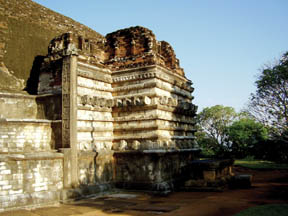|
observer |
|
|
|
|
|
OTHER LINKS |

|

|

|
|
|
|
|
There are two reasons why Mihintale is important to us. The first is, it's a place that was blessed by the Buddha. During His third visit to Sri Lanka, the Buddha visited so many places including Mihintale.
It had been known as Sela Chetiya and was one of the Solosmastana (the 16 venerated places) as well. The second reason, the more well-known one, is the arrival of Mihindu Thera, who brought us the precious gift of Buddhism. There is proof of his arrival in Mihintale; there is an inscription which says, "Here there were statues of Mihindu Thera and others".
"Mihintale is the most suitable and the nearest to Anuradhapura, for a rock cave complex", says Bandara. Mihintale is only eight miles (13 km) from Anuradhapura. The complex has provided accommodation to more than 2,000 monks, and contains all the elements that should be there to serve their needs. It includes Danashalas (alms halls), Vedahala (hospital), ponds (named Singha Pokuna (Lion Pond), Naga Pokuna and Kaludiya Pokuna) and water tanks.
|
|
There are a few stupas as well; these are named Mihintale Maha Seya (believed to be the main stupa), Ambastala Maha Seya, Kantaka Chetiya and Indikatu Seya. There is another stupa which has not been identified yet.
This rock cave complex happened to be the most developed site in the era. According to Bandara, the Visuddhi Margaya, written by Buddhagosha Thera, says there were four main well-developed and world-renowned temples in the Anuradhapura era, which were Mihintale, Haththikuchchi, Dakkinagiri and Situlpavuva. We will soon feature the other places as well in this page.
The Mihintale site, covering an area of 450 acres, consists of four mountains - Mihintale Kanda, Athvehera Kanda, Anaikutti Kanda and Rajagirilena Kanda.
Rajagirilena Kanda
This mountain provides space for a few rock caves, which were used by the monks who lived there. Stone inscriptions, which had been found beside the rock caves, describe the person who built the place and gifted it to the monks.
These rock caves give us an idea about what the old rock caves looked like. There is another Tam Lipiya (pillar inscription) written with Nagari letters.
Vedahala
This was a large building with many rooms. There is a Beheth Oruwa (a medicine boat), which had been filled with medicated oil and where the patient was asked to lie down, when being treated. It was used to treat patients with rheumatism.
This Beheth Oruwa is seven feet long, two feet and six inches wide, and two feet deep. The Department of Archaeology has found a few clay pots and blue boxes, which are believed to be proof of the cultural and business relationships that had existed those days between Sri Lanka and Persia.
Mihindu Seya
This stupa was built by King Uththiya, the younger brother of King Devanampiya Tissa. This is one of the earliest stupas of ancient Sri Lanka. Brahmi letters had been inscribed in the bricks discovered from the stupa.
The structure we see today is believed to be different from the earlier stupa, as there is evidence that it had been renovated. According to the Mahawamsa, this stupa contains some relics of Mihindu Maha Thera; the other relics are enshrined in the stupa at Rajagala, which we featured in an earlier issue.
Singha Pokuna
This is one of the most fascinating ponds in the Mihintale site and is covered with beautiful carvings. Though it's called Singha Pokuna, it's not actually a pond, but a water spout (Diya pihilla). Water comes out from the mouth of a life-size carved lion. The water has been obtained through clay pipes from the Naga Pokuna, which is situated above.
Mihindu Guhava
This is situated about 300 yards towards the east of Mihintale Maha Seya. This is believed to be the place where Mihindu Thera meditated. This stone cave also contains a seat made of stone.
Danashala
This is the place where the monks had partaken of their meals, and had made important decisions about the administration of the temple. This building is 114 feet long and 77 feet wide. The southern corner of the building had been used as a kitchen.
It houses two containers, which are believed to have been used to store rice. Water had been brought into the building through pipes from the ponds. Many details about the alms hall, including the people who did the cooking, has been revealed from a Puvaru Lipiya.
********************
Correction
The caption for the photograph of the Buddha statue featured in the Heritage Splendour page of May 28 should read as bronze statue and not as pure gold statue.










